Human Interest
Apollo 11, fifty years later
Apollo 11, which flew fifty years ago, remains today the most marvelous scientific achievement of the United States. Will we ever repeat it?
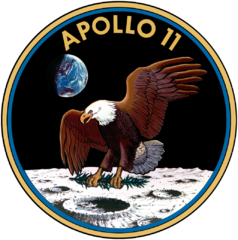
Fifty years ago tomorrow, three brave men “boldly went where no man had gone before.”1 They climbed into a tiny capsule atop a three-stage ballistic missile. Those men knew that missile could blow up from under them—but by then everyone involved made it look easy. And at exactly 0932 hours 16 July 1969, that missile blasted off. Apollo 11 was on its way.
Today the only people who seem willing to celebrate this remarkable achievement are those of us alive at the time. Among whom, count your editor—and I am not ashamed so to “date myself.” Herewith, then, a complete description of what watching the flight of Apollo 11 was like.
Apollo 11 actually began more than a decade earlier
Apollo 11 could never have flown if many other events had not taken place before it So its story properly begins with the launch of the first-ever artificial satellite: Sputnik.
As Tom Wolfe (The Right Stuff) describes, ordinary Americans had dire visions of what else the Union of Soviet Socialist Republics might launch. People feared a low-earth orbital strategic bomber, dispatching nuclear re-entry vehicles by direct control by a pilot. Naturally the call rang out—on both sides of the aisles in Congress—to make the Russians think twice. To do that, so the theory went, Americans must show that whatever they did, we could do better.
Cultural preludes to Apollo 11
Your editor was born seven weeks after that event. So by the time your editor reached school, Sputnik had had its effect on American culture. Now every child must learn basic science—in grammar school. In free time, popular entertainment featured intrepid men flying in space—and doing many of the same things similar men did on Earth. Even toymakers responded. But the toy market went farther than imitations of fanciful spacecraft. A child (especially a boy) could build and fly real rockets. These rockets flew either by water under pressure or by solid-fuel rocket engines. These engines used the same kind of powder common fireworks used then and now.
But even before such toys became widespread, real men were still trying to build real rockets. The only problem (again, according to Wolfe): our rockets always blew up. Or so it seemed. Project Vanguard became a by-word for American embarrassment—until at last the project succeeded and set up two satellites. Now the space program was under way.
Project Mercury
But President Dwight D. Eisenhower would not let matters rest there. He (and then-Senator Lyndon Baines Johnson, D-Texas) insisted on flying men into space, as rapidly as possible. “Ike” did insist on one critical refinement to what became Project Mercury: to recruit test pilots, not rank amateurs. That decision would take on an importance on which perhaps neither man reckoned.
In fact, Project Mercury was more reactive than proactive from the beginning. The agency now known as the National Aeronautics and Space Administration (NASA) selected seven test pilots from all three branches of military aviation—Air Force, Navy, and one Marine. But the project scientists and administrators expected those seven to behave almost like the chimpanzees they also worked with. The seven men—now calling themselves astronauts—proved them wrong. Being pilots, they insisted on flying as pilots. That forced radical redesigns of their intended re-entry vehicle (the “capsule”) to include things like windows—and manual controls. All astronauts (except for “mission and payload specialists”) have flown as pilots ever since.
Let’s put somebody up there!
Still, the overabundantly cautious NASA hesitated to send one of the seven into space. Instead they sent their first chimpanzee, named Ham. The test pilot community, especially at Edwards AFB (from which, ironically, NASA had recruited its Air Force contingent), laughed aloud.
Then Yuri Gagarin changed everything. On 11 April 1961, he became the first human being to fly in space. By then, America had a new President, John F. Kennedy. And Kennedy realized the implications at once. So, two things happened. First, NASA did send a man into space: Alan Shepard, who lifted off on May 5. Twenty days later, President Kennedy addressed a joint session of Congress and gave it this bold message:
I believe that this nation should commit itself to achieving the goal, before this decade is out, of landing a man on the Moon and returning him safely to the Earth.
More reactive changes of plan
NASA followed up Shepard’s flight on July 21, 1961, with Gus Grissom. That flight ended in near-tragedy—because Grissom made the flight without incident, but lost his capsule after spashing down. (Did he blow the hatch too soon by accident? Or did something else go wrong? NASA still won’t talk about it, even though the Navy has since recovered Grissom’s capsule.)
NASA had planned more suborbital hops—and again the Russians “intervened.” Gherman Titov took off and overflew United States territory. NASA changed its plans at once: they planned to send up Marine Col. John H. Glenn, this time into orbit. That meant using a yet-untried launch vehicle, the Atlas. Glenn, undaunted, told NASA he was ready. The engineers had to try twice with Glenn’s craft—but the second time proved the charm, and John Glenn made it into orbit.
Project Gemini, immediate prelude to Project Apollo
Project Mercury ended three flights later. Every man among the original seven went up once—except Donald K. Slayton, who developed a cardiac dysrhythmia. NASA grounded him, but the astronauts banded together to give him a new job—as their chief.
The next project, using a larger capsule, involved sending two astronauts at a time. Hence the name of the project: Gemini, for the Twin Gods. With this project, NASA perfected many of the techniques on which the lives of the Apollo 11 crew would depend. These included rendezvous, docking, and spacewalking (“extra-vehicular activity”).
Project Apollo begins—with tragedy.
In 1967 came Project Apollo—and the first major tragedy. Gus Grissom, Ed White, and Roger Chafee climbed into a three-man capsule for a dress rehearsal. A spark in the oxygen-saturated air started a fire—and the astronauts, sealed in, could not escape. Then-President Johnson buried them with full military honors. Then, ironically, Johnson was off to Moscow in April of 1967—to take part in a Russian cosmonaut’s funeral. Vladimir Komarov, piloting Soyuz 1 (literally, Union 1), died when his ship lost its parachute, and crash-landed.
The missions of Projects Mercury and Gemini had all played out on live television in America. Now the television broadcasts fell silent. Most of your editor’s contemporaries forgot that Project Apollo still existed. But the project engineers were still at work, sending up five empty capsules for various orbital maneuvers.
Then NASA abruptly returned to television in a big way.
Would Apollo 11 ever make it?
Apollo 7 took ordinary people by surprise. Before then, many thought the project had died. This included a Hollywood production company that made a movie, Countdown (rel. February 1968), about a desperation mission. In it, the Soviet Union prepares to send a two-man crew to the moon. So NASA quickly sends one astronaut on a one-way mission: to land on the Moon and transfer to a shelter.
No such mission even made it to the planning stage. But on October of 1968, about twenty-two months after the tragedy named “Apollo 1,” came Apollo 7. The country saw three men go up in a capsule, and come back down—safely. And breathed a collective sigh of relief.
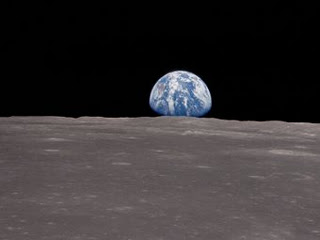
Relief turned to elation during the Christmas season of 1968—because Apollo 8 left Earth orbit and entered orbit around the Moon for the first time.
The last demonstrations
In 1969 came Apollo 9, the first demonstration of the new Lunar Excursion Module—later renamed plain “Lunar Module.” Apollo 10 would demonstrate the LM again, this time on a mission to come within a whisker of an actual landing.
With that, NASA had set the stage. Nevertheless, Neil A. Armstrong and Edwin “Buzz” Aldrin, Jr., the two who would fly a LM to land on the Moon, knew they were taking a tremendous risk. No pilot likes to fly any kind of craft that has never flown before—on a critical mission. But NASA now asked these two men to do precisely that.
Apollo 11 lifts off
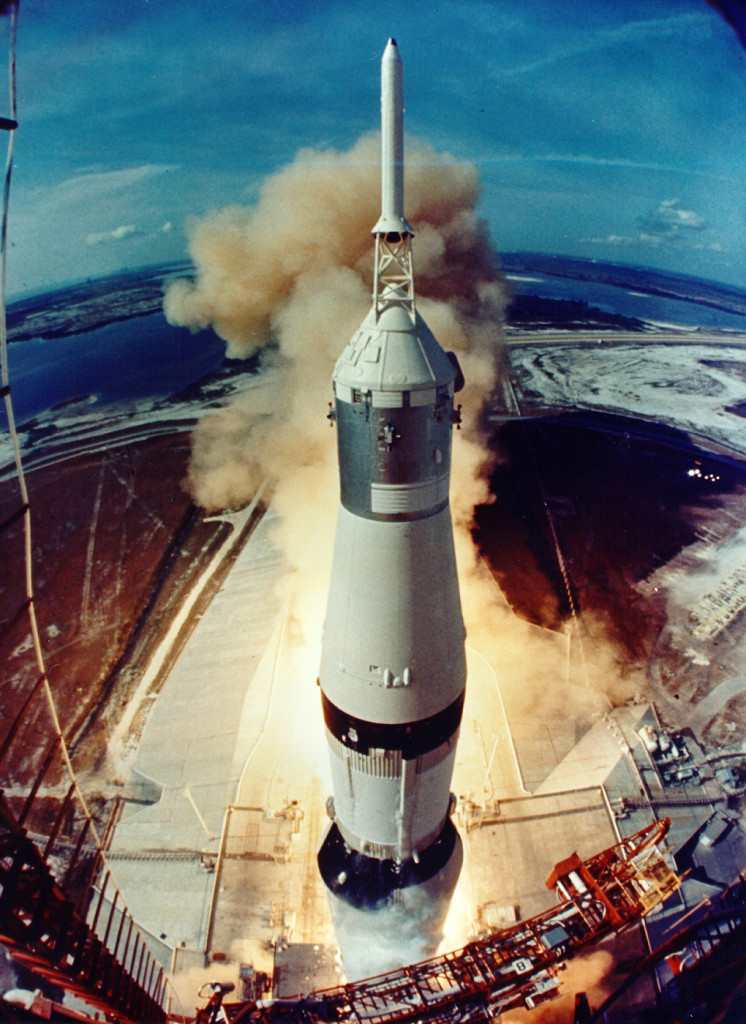
Everyone in America, it seemed,
waited with bated breath for Apollo 11 to begin. On July 16, 1969,
barely a soul in America was not paying attention. The
massive Saturn V rocket lifted off without a hitch. But nobody was
relaxing. No one could—because this was only the
beginning. The
three-man crew (including Michael Collins, who would pilot the
capsule) still had a long trip ahead of them.
The next four days included one milestone after another. People watched the Apollo 11 crew as they:
- Left Earth orbit,
- Retrieved the LM from its protective coverings, and then
- Slowed down to put themselves into orbit around the Moon.
Apollo 11 lands
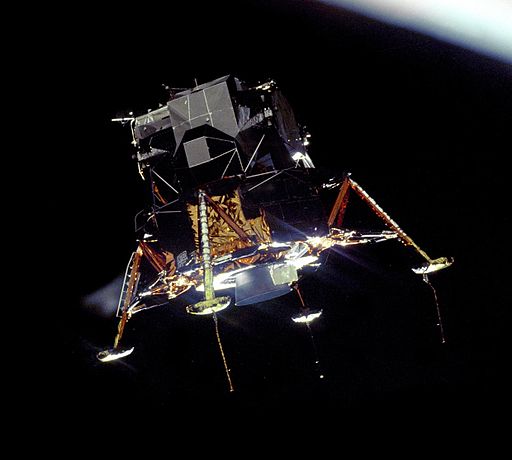
Sunday, July 20, saw the most tension-packed activity of all. First, Armstrong and Aldrin, having climbed into their LM and undocked, piloted their craft to a landing. That in itself would have held enough drama to make up for twenty-two months of inactivity. But the controllers in Houston, Texas were still biting their nails. They could not know whether the Apollo 11 LM would sink into a cloud of dust. For that reason, the LM carried four sensors, about a meter long, that would shut off the descent-stage engine when all four signaled contact. Otherwise, the engineers feared, Apollo 11 might blast a hole in the dust only to have it bury them!
The boulder field
As if that didn’t cause enough worry, Astronaut Armstrong had to override the computer program for the landing at the last minute. As he later described it, he was about to land in a football-field-sized crater with boulders the size of automobiles! He had no time to “clear” it with the ground controllers. So he seized the controls, moved the LM to a flat spot, then let the LM continue down.
Everyone in “Mission Control” waited—as did the country, either listening on radio or watching a pure-guess animation on television. The only real indication anyone had were the crew’s voices.
Contact!
Finally, “Buzz” said, “Contact light!”
Armstrong followed this with, “OK, engine stop!” and a few other rapid-fire reports.
“CapCom” Bruce McCandless then said, “We copy you down, Eagle,” using the name the crew had given the LM.
The world had to wait two seconds for the next voice. (The Moon is far enough away for the time for a radio message to travel back and forth becomes significant.) Then came Armstrong saying, “Houston—ah–Tranquility Base here. The Eagle has landed.”
And Bruce McCandless said, “Roger, Twank—er, Tranquility, we copy you on the ground. You’ve got a bunch of guys about to turn blue. We’re breathing again. Thanks a lot.”
That was the understatement of the mission. That conversation took place at 4:18 p.m. Central Daylight Time—Houston time.
A call for prayer
Two and a half hours later, “Buzz” Aldrin came on the radio and called for prayer, saying:
This is the LM pilot. I’d like to take this opportunity to ask every person listening in, whoever and wherever they may be, to pause for a moment and contemplate the events of the past few hours and to give thanks in his or her own way.
The Apollo 11 moonwalk
Once again the people had to wait, for about four hours, to see or hear anything else. During that time, the news networks entertained viewers with demonstrations of an Apollo moonsuit and what Armstrong and Aldrin would do after they left their craft.
So
at about four minutes to 11:00 p.m. Houston time, TV viewers saw the
same demonstration they had seen before. Then the demonstrator pulled
a lever—and Neil Armstrong pulled the real lever on the Moon. Now
everyone could see something real! At first the picture was upside
down—so NASA flipped the picture they were getting.
Armstrong took the LM ladder one step at a time, talking all the way. The controllers were still scared that he would sink into a dry quicksand!
And then…
“And there’s the foot on the Moon! There’s the foot standing on the Moon!” So said Walter Cronkite, reporting for CBS.
And Neil Armstrong added,
That’s one small step for man, one—giant leap—for mankind.
Solid ground after all
Armstrong didn’t sink. The dust on the moon turned out to be only six to eight inches deep.2 Below this was hard, coherent regolith. Armstrong first collected a sample and slung it on his belt—in case he had to take off fast.
He then unshipped the camera from its cradle on the LM, panned all around him, and remounted the camera on a tripod. From then on, viewers could see the LM, Armstrong—and Aldrin, who joined him. The quality of the TV pictures was horrendous, of course—NASA could not transmit using NTSC signals!
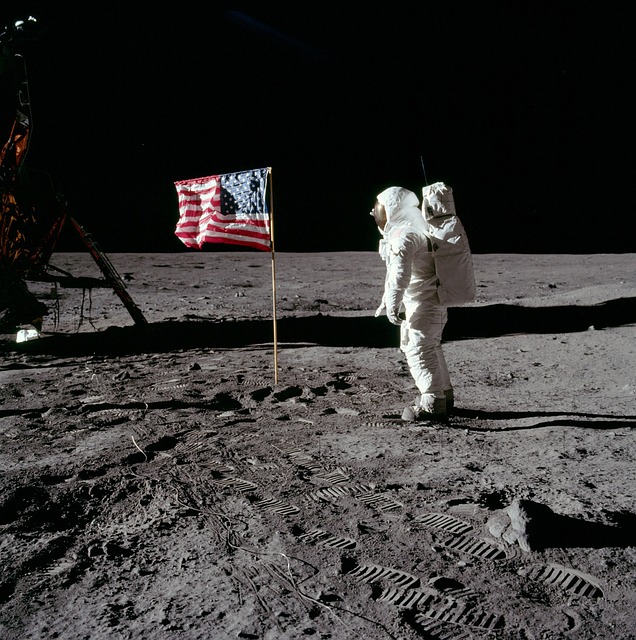
The
two men, once they were both on the moon, started having fun jumping
like gazelles in the low gravity. Then they got down to business:
planting an American flag, taking samples, and setting up
experiments. They
also took a direct call from President Richard M. Nixon from the Oval
Office. Millions
of people stayed up past their
local
midnight (Central
and Eastern)
to take all this in.
Apollo 11 returns
All good things must end, of course. Armstrong and Aldrin spent 21 hours total on the Moon before they had to lift off and return to orbit. Once again, the American people had to settle for radio, or prepared animation.
Armstrong told the country later that the LM ascent engine blew the flag over. He and Aldrin had planted it too close to the LM. The five successive landing crews would plant their flags further away, to prevent this happening again.
The return trip was anticlimactic. Everyone had seen a splashdown, of course, so the homecoming of Apollo 11 looked routine—at first. But now began 21 days of quarantine for the astronauts—because NASA wasn’t sure they hadn’t picked up an infection in space. Two missions (Apollo 12 and Apollo 14) later, NASA would conclude that the Moon had no life on it. The three subsequent crews did not have to go into quarantine.
The Apollo 11 controversy
Sadly, the controversy about whether Americans had ever gone to the Moon started about three or four years later. Your editor can still remember schoolmates scornfully saying,
We didn’t go to the Moon! They just fooled us all with wires and mirrors!
Hollywood didn’t help. Albert R. “Cubby” Broccoli, owner of the James Bond franchise, struck the first unkind blow. In Diamonds Are Forever (1971), James Bond, investigating diamond thefts, blunders onto a sound stage in Las Vegas. There he finds moonsuit-wearing figures pretending to be taking lunar samples!
A deadly conspiracy
Then, two years after the last Apollo mission (Apollo 17), the cynical Sir Lew Grade distributed his conspiratorial blockbuster. In Capricorn One (1977), three astronauts climb into an Apollo capsule to go to Mars. Then a business-suited figure opens the hatch and orders them to leave the capsule and follow him! The astronauts travel to an abandoned World War Two training base 300 miles west of Houston. The NASA administrator then orders them to act out the flight to Mars, the landing, and the return trip.
All goes well—until the real, empty capsule burns up on re-entry. Now the astronauts make a desperate bid to escape. Meanwhile, an enterprising reporter dodges federal drug agents and would-be assassins to find at least one of them and bring him home. The mission commander’s wife provides the vital clue. In the acting-out, the commander talks about taking the family to a place where they hadn’t gone. And where they really had gone was a movie set—then in use! In other words, they really had visited a place where people staged something for entertainment!
An altercation
Astronaut
Armstrong is now dead. But Edwin Aldrin still lives. Once,
a “we never went to the Moon” theorist confronted Aldrin and
asked him to denounce the Apollo 11 story. Words failed Aldrin; he
literally swung
his fist
and knocked the other man flat.
America stood down
Equally sadly, America stood down from anything as grand as going to another world. Besides fueling the we-never-went-to-the-Moon controversy, this shamed American pride.
At first America continued to send men into space. First came the Apollo-Soyuz Test Project, in which an Apollo capsule docked with a Russian Soyuz capsule. That mission succeeded—and Donald K. Slayton actually returned to space to take part in it.
The USA and the USSR both put space stations in orbit—Skylab and Salyut. Neither station remains in orbit today.
While the Russians built another station, called Mir, NASA built the Space Shuttle. Rockwell International built five working shuttles in all (Columbia, Challenger, Discovery, Atlantis, and Endeavor), plus one dummy (Enterprise). Of the six, Challenger and Columbia perished, the one on take-off, the other on re-entry—with all hands. The rest now sit in museums.
Mir fell out of the sky and burned. But a new International Space Station has taken its place. So far, only a Russian Soyuz can carry relief crews and bring back astronauts after a year’s stay.
How will America return to space?
Two projects are in the works to let America send its own astronauts aloft. NASA is running one the old-fashioned way—with one prime contractor, but still running everything itself. But also, Elon Musk’s Space Exploration Company, or SpaceX, has been acting like a one-stop shop for years. They developed recoverable boosters as well as a recoverable capsule for sending supplies and bringing back trash—and treasure. The treasure takes the form of film, samples, and other things of scientific value. Now SpaceX hopes to invent and place in service its own heavy-lifting rocket, and a spacecraft for human beings.
But the same political pressures that grounded Project Apollo after six moon landings can always work again. The reasoning runs thus:
It doesn’t affect the Earth you’re living on!
Is it worth billions of dollars? Why not (take your pick of social programs)?
Nevertheless, a new project, called Artemis, hopes to take up where Apollo left off. And Elon Musk has set his sights even further away—on Mars.
Summary
Apollo 11 was a modern “wonder of the world.” CNAV explored this five years ago; see here, here and here. One can only hope that the first series of missions to another world will not be the last.
1 What entertainer Eugene Roddenberry talked about, these men did.
2 No matter what anyone else says, Walter T. Brown insists this dust is too shallow to have accumulated over 4.6 billion years.
About the featured image
The featured image is the official insigne of Apollo 11. The crew wore this on their shoulders.
Terry A. Hurlbut has been a student of politics, philosophy, and science for more than 35 years. He is a graduate of Yale College and has served as a physician-level laboratory administrator in a 250-bed community hospital. He also is a serious student of the Bible, is conversant in its two primary original languages, and has followed the creation-science movement closely since 1993.
-

 Civilization3 days ago
Civilization3 days agoDC Pipe Bomb Arrest Raises Questions About Christopher’s Wray’s FBI
-

 Civilization4 days ago
Civilization4 days agoThe Legal Logic Behind U.S. Operations Against Narco-Terrorist Networks
-

 Executive4 days ago
Executive4 days agoNewsom’s ‘National Model’ for Homeless Wracked by Fraud
-

 Executive3 days ago
Executive3 days agoWhen You’re in a Hole, Stop Digging
-

 Education3 days ago
Education3 days agoWaste of the Day: Taxpayers Subsidize Football Coach Severance
-

 Executive2 days ago
Executive2 days agoWaste of the Day: Obamacare Failed Test, Approved Fraudulent Subsidies
-

 Civilization2 days ago
Civilization2 days agoPence Calls on Trump To Fire RFK Jr Over Abortion Drug
-

 Executive4 days ago
Executive4 days agoWaste of the Day: Feds Pay Nonprofits That Sue the Government





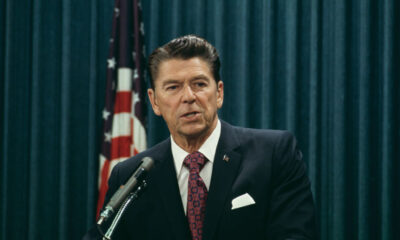



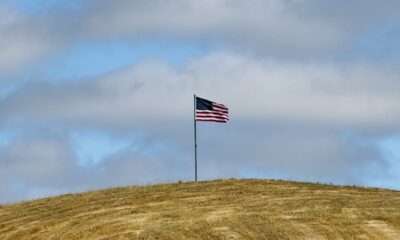



[…] Report. Today I will be talking about and remembering the Apollo 11 mission which has its 50th anniversary this week. Fifty years ago, July 20, 1969 Neil Armstrong did what no human had ever done before; he […]